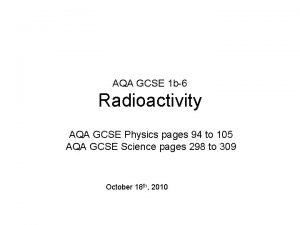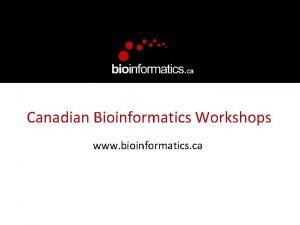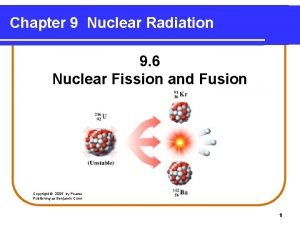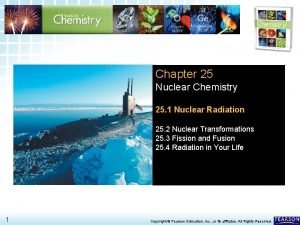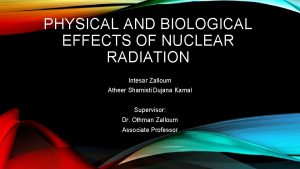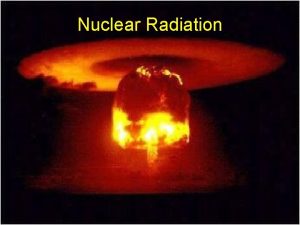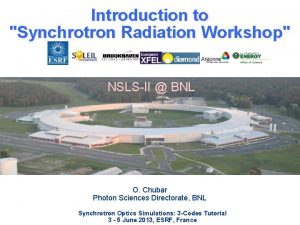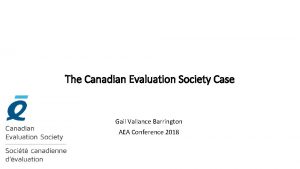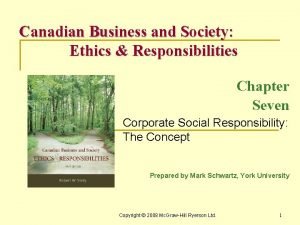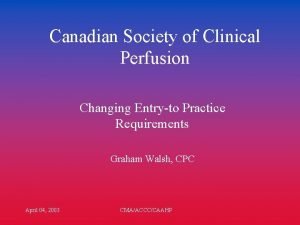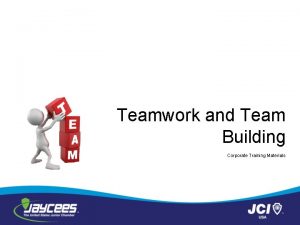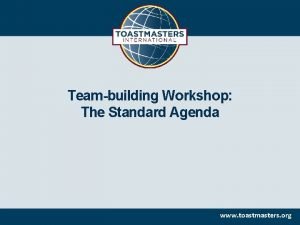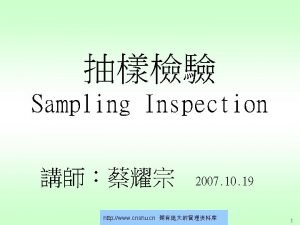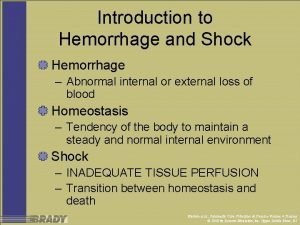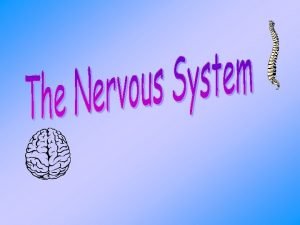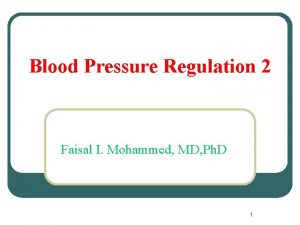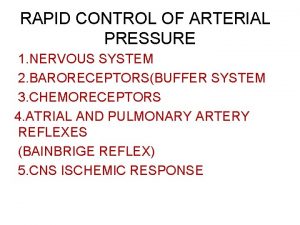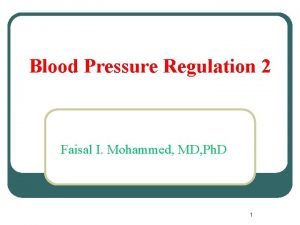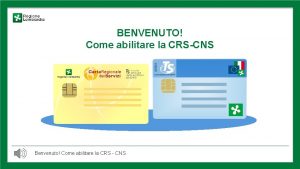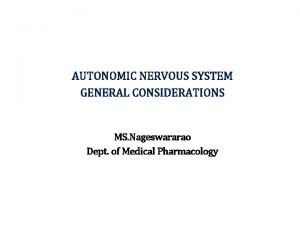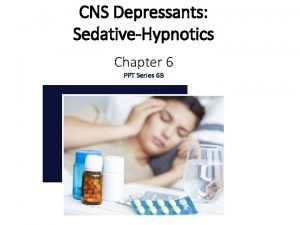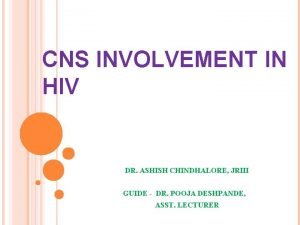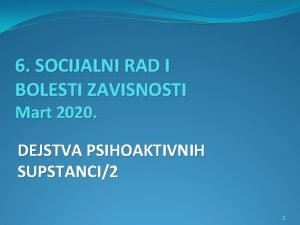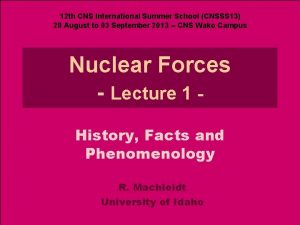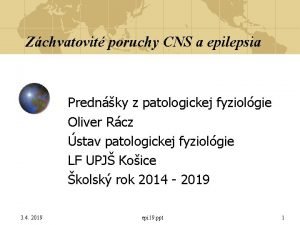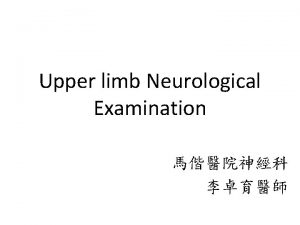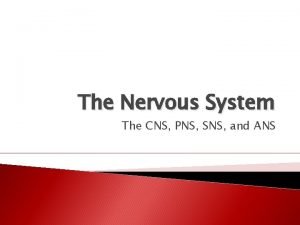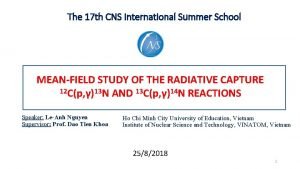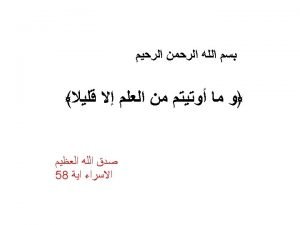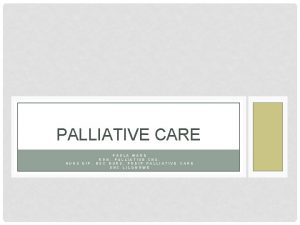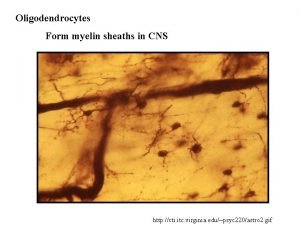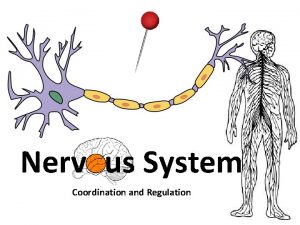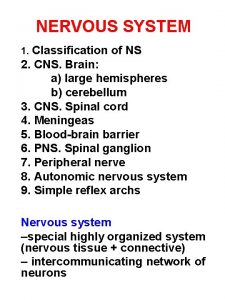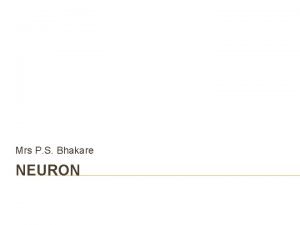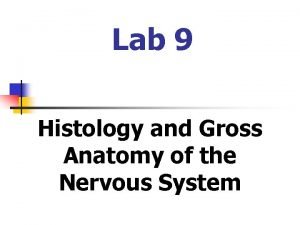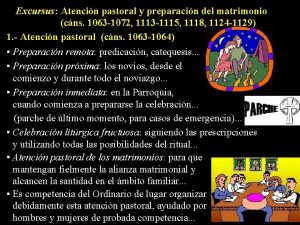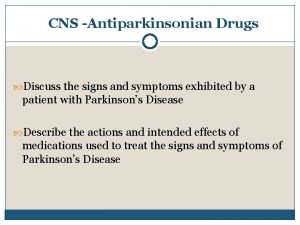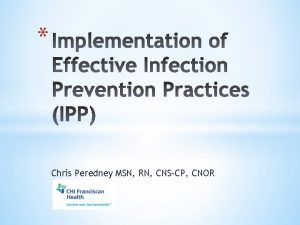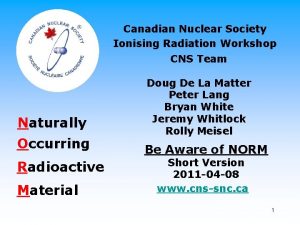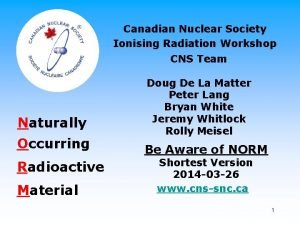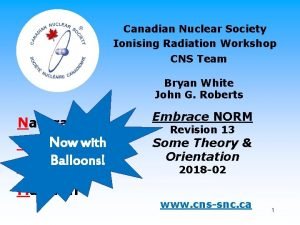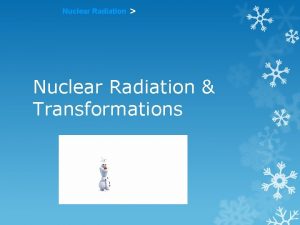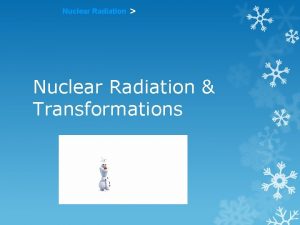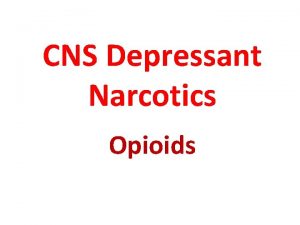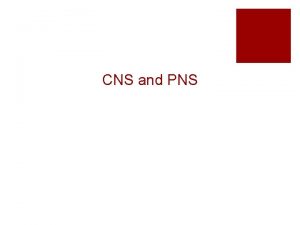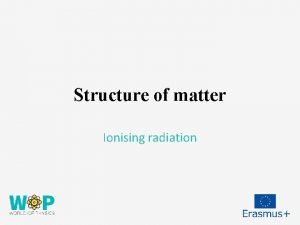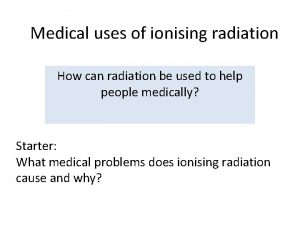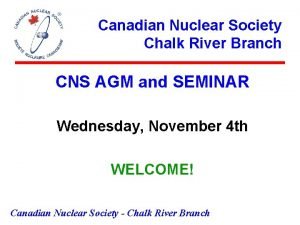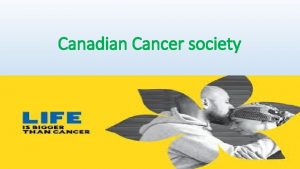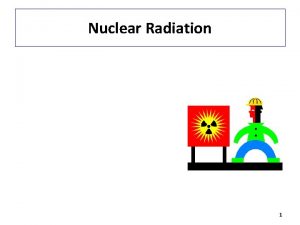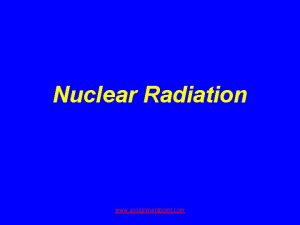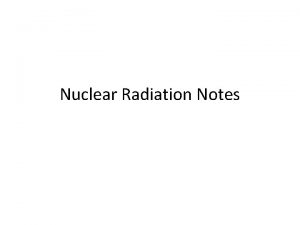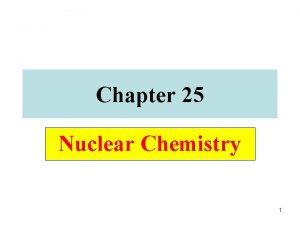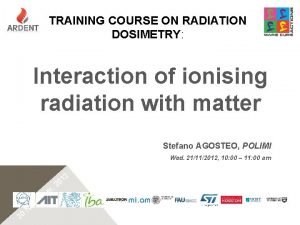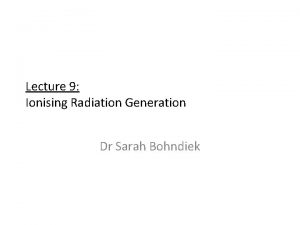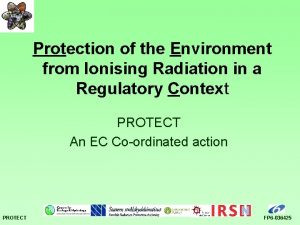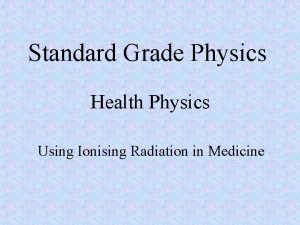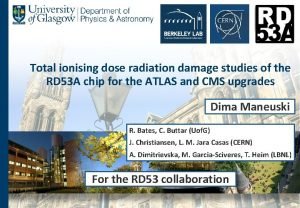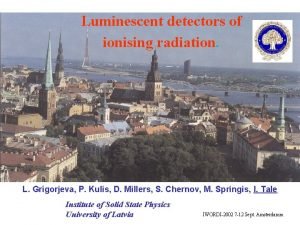Canadian Nuclear Society Ionising Radiation Workshop CNS Team
















































- Slides: 48

Canadian Nuclear Society Ionising Radiation Workshop CNS Team Bryan White John G. Roberts Naturally Now with Occurring Balloons! Radioactive Embrace NORM Revision 13 Experiments 2018 -02 Material www. cns-snc. ca 1

The ionising radiation workshop kit… Geiger counter USB Interface Computer If your table has a computer, please don’t disturb it -- we’ll get to it shortly. 2


Outline: 1. This ends the Introduction 2. Some theory and orientation 1. What is Radiation? 2. Electromagnetic Radiation; “particle” radiation 3. Non-ionising & Ionising Radiation (UV, α, β, γ, n, ν) 4. Radioactive decay; periodic table and chart of the nuclides 5. Fission (spontaneous and induced) 3. Detecting Ionising Radiation

Outline continued: 4. Experiments: 1. Getting Started 2. Background Radiation 3. Potassium-40 4. Thorium 1. Absorbers 2. Range 5. Uranium 1. Sources 2. Hot Balloons!

The Geiger Detector Geiger hygiene: PLEASE Don’t break the window!

Geiger Counter Experiments: -- Making Ionising Radiation Hands-on and REAL for your students • Experiment 0 • A procedure for setting up the Aware Electronics Aw-Radw program parameters from scratch

Geiger Counter Experiments: -- Making Ionising Radiation Hands-on and REAL for your students • Experiment 1 • Background measurements and observing shielding effects

Experiment 1: Background • Monitoring background shows that ionising radiation is everywhere • Background “measurements” can be tricky and time consuming – Short counting intervals give small average numbers of counts -- lousy statistics – long counting intervals are BORING – effect of shielding is easy to show



Find the background running average on your screen Workstation Running Average 1 2 3 4 5 6 Average for 6 12

Experiment 1: Background & Shielding • A container of water provides shielding to reduce background count • cream or juice cartons with flat sides are useful • Geiger is on a little base so it stands up straight

Experiment 1: Background and Shielding Counting for 10 minutes may not produce consistent results 14

Excerpts from the NORM fact sheet With long background counts the fit to a normal distribution is not perfect. The count rate is not constant (non-stationary process) Applying a one hour moving average filter shows the “average” background count rate changes with time.

Geiger Counter Experiments: -- Making Ionising Radiation REAL for your students • Experiment 2 • making a simple set of measurements with weak sources such as Salt Free -- KCl is a convenient 40 K source available in your grocery store $6. 99 $4. 79

To select Autoscale, Click on bargraph “Options”, select Auto Scale Y-Axis and click.



Experiment 2 -- 40 K • Salt Free ~5 k. Bq / $4. 79 in grocery store • potassium: – a nutrient, essential to life, – used in heart surgery to save lives and for lethal injections, and it’s radioactive!

Experiment 2 -- 40 K The CNS potassium-40 fact sheet includes this table

Geiger Counter Experiments: -- Making Ionising Radiation REAL for your students • Experiment 3 • measurements with a specific group of vintage cameras. These include measurements with absorbers to distinguish alpha, beta, and gamma content; and • a set of measurements as a function of distance in air

Experiment 3: 232 Th in vintage camera lenses • Vintage cameras provide intense source of alpha, beta, gamma • short count intervals: range and shielding measurements • clunky rangefinder cameras work well and may be found on e. Bay • alignment and geometry are important

Experiment 3: 232 Th in vintage camera lenses From about 1950 through to 1980, several consumer cameras were made using thorium oxide in the glass lens to: • enhance the refractive index of the glass, and • keep the dispersion low

Experiment 3: 232 Th in vintage camera lenses For high school demonstration experiments, these lenses are a conveniently “bright” source of particles. The radioactive material is embedded inside the glass of the lens, and most of the particle emissions are absorbed by air.

Experiment 3: 232 Th in vintage camera lenses Using such “bright” sources that provide counting rates at or above 5000 counts per minute, many measurements can be made in a short time (accepting the statistical errors that result), and students are more likely to remain engaged in the process

Experiment 3: 232 Th in vintage camera lenses The following decay sequence shows that alpha, beta and gamma radiation are present. The alpha and beta can be filtered out of the measured beam.

Kodak Signet 40 camera lens This bar is off -scale high background KCl -- No. Salt®

Experiment 3: 232 Th in vintage camera lenses Shielding / absorbers Multiple Absorbers Mean Count (20 s) for Number of Aluminum Foil Absorbers 0 no paper 1861 paper 1882 0. 1* 1686 1 2 3 4 5 6 7 1748 1733 1531 1470 1372 1349 1627 1569 1503 1424 1373 1328 1296 * Offset to 0. 1 foils for paper absorber alone for clarity 8 1267

Absorber experiments The Geiger is shielded with incremental aluminum foils and produces very different results if a paper absorber is used to absorb the alpha radiation in front of the foils.

Experiment 3: 232 Th in vintage camera lenses Distance • Signet 40 lens with absorbers: • paper, 3 Al foils, paper • aligned with Geiger at the minimum separation (bezel ring removed gives 6. 6 mm) • ring installed (8. 6 mm) • separation increments of 1 cm Signet 40 lens with paper, 3 foils, paper absorbers -- range data Separation [mm] Mean count (20 s) 6. 6 8. 6 18. 6 28. 6 38. 6 48. 6 58. 6 68. 6 1167 1080 765 546 384 289 220 179

Experiment 3: 232 Th in vintage camera lenses 1800 Signet 40 range test with paper, 3 Al foil, paper absorbers 1600 1400 Count (20 s) 1200 1000 800 600 400 200 0 0 Camera lens to Geiger window Separation [mm] 10 20 30 Count (20 s) 40 50 R-square fit 60 70 80

Experiment 3: 232 Th in vintage camera lenses Range We don’t see “inverse square law spreading”? Why not?

Experiment 3: 232 Th in vintage camera lenses Range • The lens is not a “point source”: –normally this is treated as in optics by imagining a “virtual point source” behind the physical lens • The Geiger window is bigger than the lens: –as the range is increased the Geiger still detects a similar fraction of the radiation Real measurements aren’t as tidy as text book illustrations!


Geiger Counter Experiments: -- Making Ionising Radiation REAL for your students • Experiment 4 • Measurements made with uranium sources – The Hot Balloon Experiment a freely available source! • Other uranium sources such as Vintage “Vaseline Glass, ” “Fiestaware” saucers, and photogray eyeglass lenses made prior to 2000.

The CNS has launched a You. Tube Channel for the Ionising Radiation Workshop So far there are only 2 videos up: There will be many more when I get around to it.

The Hot Balloon Experiment

Experiment 4: The balloon experiment NEW • The balloon is an electrostatic precipitator collecting dust particles from the air. • The α decay of 222 Rn (3. 82 day) to: 7. 218 Po (3. 1 min) – α 8. 214 Pb (26. 8 min) – β- 9. 214 Bi 10. 214 Po (19. 9 min) – β- These dominate the balloon data (164 µs) – α 11. 210 Pb (22. 2 year) – β- 12. 210 Bi (5. 012 day) – β- 13. 210 Po (138. 4 day) – α 14. 206 Pb (stable) 39

40

10000 Purple Balloon & paper, 31 minute half-life, log scale Counts per minute 1000 10 09: 05 10: 17 11: 29 12: 41 Purple balloon, paper. Time 13: 53 15: 05 16: 17 17: 29 Selected half-life 41

5000 Counts per minute for balloon, paper to absorb alpha Counts per minute 4000 3000 2000 1000 0 1 61 121 181 Minutes (aligned) Balloon, paper 241 301 2 separate experiment data sets without and with a paper absorber. The paper absorbs most of the alpha and some of the lower energy beta and gamma. Black includes alpha, red doesn’t.

180 Plastic Food Wrap Roll side up 160 Counts per minute 140 120 100 80 60 40 20 0 16: 07 16: 36 17: 05 17: 34 18: 02 18: 31 Time 19: 00 19: 29 19: 58 20: 26 20: 55 43

Vintage Vaseline Glass -- a uranium source • Uranium compounds added to glass give it a green-yellow hue and it fluoresces under UV light • It provides alpha, beta, & gamma radiation, but is not as intense as the vintage camera lenses.

Fiestaware -- a bright uranium source • Uranium compounds added to the ceramic glaze give these saucers a red-orange hue (and no they don’t fluoresce under UV light) • The maximum count rates at minimum separation with an RM-80 are about 30000 cpm and 20000 cpm for these two samples

Other uranium sources: Pre-2000 “photogray” glasses Normalized CPM Distribution Photogray Lenses 60% 50% 40% 30% 20% 10% 0% 0 20 40 60 80 100 120 140 Count Rate Background PG Count Back Ref Norml PG Ref Norml 160

Other uranium sources: Pre-2000 “photogray” glasses Spectrum from UOIT

Other uranium sources: Granite countertops 50% Granite Counter Top & Marble Floor Tile Count Distributions 40% 30% 20% 10% Marble Floor 0% 20 40 Granite Countertop 60 Marble Ref Norm 80 Granite Ref 100 120
 How to calculate half life physics
How to calculate half life physics Canadian bioinformatics workshop
Canadian bioinformatics workshop Canadian bioinformatics workshop
Canadian bioinformatics workshop Canadian bioinformatics workshop
Canadian bioinformatics workshop Canadian bioinformatics workshop
Canadian bioinformatics workshop Lesson 15 nuclear quest nuclear reactions
Lesson 15 nuclear quest nuclear reactions Fisión nuclear vs fision nuclear
Fisión nuclear vs fision nuclear Nuclear fission radiation
Nuclear fission radiation Types of radiation
Types of radiation What is nuclear radiation
What is nuclear radiation Nuclear radiation
Nuclear radiation Synchrotron radiation workshop
Synchrotron radiation workshop Canadian evaluation society
Canadian evaluation society Triple e bottom line
Triple e bottom line Canadian society of clinical perfusion
Canadian society of clinical perfusion Teamwork training module
Teamwork training module Team building workshop agenda
Team building workshop agenda Cns2779
Cns2779 Naas cns
Naas cns Haemorrhage
Haemorrhage Site:slidetodoc.com
Site:slidetodoc.com Composition of cns
Composition of cns Cns ischemic response
Cns ischemic response Cns ischemic response flow chart
Cns ischemic response flow chart Cns ischemic response
Cns ischemic response Www.lispa.it cns
Www.lispa.it cns Ans and cns difference
Ans and cns difference Cns depressants ppt
Cns depressants ppt Cns
Cns Depresori cns
Depresori cns Cns international school
Cns international school Cns poruchy
Cns poruchy Grades of power cns
Grades of power cns Dermatome map
Dermatome map Cns summer school
Cns summer school Thermoreceptors def
Thermoreceptors def Cns ward
Cns ward Cns
Cns Parts of central nervous system
Parts of central nervous system Structure of the reflex arc
Structure of the reflex arc Classification of ns
Classification of ns Soma cns
Soma cns Neuron histology
Neuron histology Cns
Cns Cns educar
Cns educar Soma cns
Soma cns Cns
Cns Cns-cp
Cns-cp Cns depressants classification
Cns depressants classification
